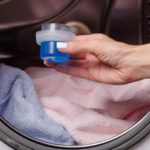If you’ve experienced an outbreak of bed bugs, you’ll want to eradicate them quickly.
Although not a standalone solution, one way to help reduce the number of bed bugs is to launder your clothes. However, you must use the correct laundering practices to eliminate these pests effectively.
This raises many questions, such as which detergent kills bed bugs. Contrary to wishful thinking, the unfortunate truth is that no laundry detergent can exterminate bed bugs or their resilient eggs outright.
This article explains why and discusses alternative washing tactics you can employ to eradicate the infestation—and prevent it from returning in the future!
What Laundry Detergent Will Kill Bed Bugs?
Unfortunately, there is no laundry detergent that will kill bed bugs or their eggs. Bed bugs are resilient pests, and they typically require specialised treatments to eliminate them effectively.
With that said, laundering all your clothes with regular detergent is essential if you have a bed bug infestation.
This is because bed bug eggs have a protective outer layer that makes them more resistant to certain chemicals, including some found in regular laundry detergents.
The primary purpose of using detergent when washing infested items is to dislodge and remove bed bugs, their faeces, and other debris from fabrics by breaking down this protective layer.
Can Bed Bugs Survive the Washing Machine?
While laundry detergent may not be a silver bullet for bed bug annihilation, laundering all items of clothing remains an integral component of the overall strategy when faced with an infestation.
Bed bugs rarely survive the washing machine!
However, this isn’t because of the type of detergent you use. It’s because bed bugs are sensitive to high temperatures. The hot water from the wash and the heat from the drying process can eliminate bed bugs at various life stages, including eggs, nymphs, and adults.
Therefore, washing infested clothing, bedding, and linens in the washing machine can effectively kill bed bugs.
However, to be effective, you should wash your clothes at a minimum temperature of 50°C. The higher the temperature, the better when it comes to eradicating bed bugs.
How Do I Wash Clothes Infested with Bed Bugs?
Washing clothes infested with bed bugs needs to be done correctly, or it won’t be effective in helping to eradicate the infestation. Here is a step-by-step guide:
- Step 1: Sort and bag: Separate infested clothing from uncontaminated items. Place the infested clothing in bin bags right at the infested location. Seal the bags so that they’re airtight to prevent the bed bugs from spreading.
- Step 2: Empty the bag directly into the washing machine: When you’re ready to wash the infested clothing, take the sealed bag directly to the washing machine. This helps prevent bed bugs from escaping in transit. Throw the bag away immediately.
- Step 3: Select a hot water wash: Set the washing machine to the hottest water temperature that is safe for the fabrics, according to the care label. Bed bugs are sensitive to high temperatures, and hot water helps to kill them. Aim for a temperature of at least 50°C.
- Step 4: Add detergent: You can use a regular laundry detergent when washing clothing that is infested with bed bugs. While the detergent doesn’t necessarily kill bed bugs, it helps break down their outer protective layer and facilitates their removal from fabrics.
- Step 5: Dry on high heat: Transfer the clothes to the tumble dryer immediately after washing. Use the hottest setting on your dryer to dry the clothes thoroughly. The heat from the dryer is crucial for killing any remaining bed bugs and their eggs.
- Step 6: Store in airtight plastic bags: After drying, inspect the clothing to ensure there are no signs of bed bugs. Once confident that the items are free from bed bugs, store them in sealed plastic bags or containers to prevent re-infestation.
Should You Wash All Your Clothes After Bed Bugs?
You should wash all your clothes after a bed bug infestation, even if you have only seen the pests on a few items of clothes.
In fact, you need to wash all fabric items in your home, including bedding, pillowcases, linens, and towels.
This is because bed bugs can hide in clothing and fabric items or lay their eggs there. Wash the items infested with bed bugs first to help limit the spread of the infestation, using the method above.
You can then wash all other material items in your home, making sure you use high temperatures and store them in air-tight bags after washing.
Why Do You Need to Bag Clothes for Bed Bugs?
After washing, storing your clean clothes in airtight bags is essential. You know that the high temperatures of the washing machine and tumble dryer have killed all bugs and eggs, so these items are “safe.” However, putting them back into wardrobes and drawers now may result in a re-infestation.
This is because bed bugs might still be hiding in carpets, mattresses, headboards, and other fabric items that can’t fit inside the washing machine.
The bugs can crawl from here onto your clean clothes, making them challenging to remove completely.
Therefore, you must treat these non-machine washable surfaces before unbagging your clothes.
You’ll want to contact a professional pest control service for the best results. They will spray a pesticide that kills bed bugs on all surfaces of your home. When any surviving bugs crawl over the spay, they’ll die.
You typically need to have several treatments over a month so that any babies that hatch after the first spray are killed with later treatments.
Only once the treatment is complete can you safely unbag your clean clothes, returning them to your wardrobe and drawers.
How Do You Kill Bed Bugs on Clothing That Can’t Be Machine Washed?
As mentioned earlier, you must wash clothes at high temperatures to kill and remove bed bugs from the fabric.
Unfortunately, some garments aren’t suitable for this type of washing—the hot water temperature and motion of the drum will damage the material.
For these items, you have several alternative options:
- Dry cleaning: You can take your clothes to a professional dry cleaner. The dry cleaning process uses heat, killing the bed bugs and their eggs. However, you may have trouble finding a company that accepts infested clothes.
- Store in airtight bags: Another option is to store the clothes you cannot wash in airtight bags. Eventually, the bed bugs will die of starvation. However, they can survive up to a year without feeding on blood, so you will need to store your clothes for a long time.
- Steaming: Rather than machine washing, you can heat treat delicate garments using a clothes steamer. Run the steamer over the entire piece of clothing, then store in plastic bags. Vacuum the floor after steaming your clothes to capture any eggs or dead bugs.
- Freezing: It isn’t only hot temperatures that bed bugs are sensitive to—they also can’t survive in extremely cold conditions. Therefore, you can kill bed bugs by putting delicate clothing in a freezer for four days and then storing the garments in airtight bags.
Remember, these steps are part of a comprehensive approach to dealing with bed bugs. Washing clothes alone may not eliminate a bed bug infestation in your home.
It’s essential to address the infestation in the entire living space, including bedding, furniture, curtains, carpets, and other potential hiding places, and consider consulting with a pest control professional for effective treatment.

Hannah has a passion for cleaning. She worked her way around Australia by cleaning hostels in exchange for free accommodation and used her cleaning skills to bag a job as a chalet host for a luxury ski company in France.






